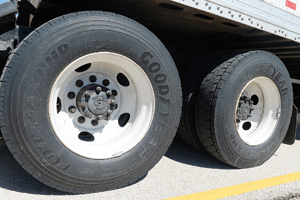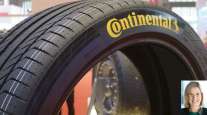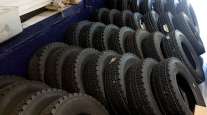Low-Rolling-Resistance Tires Save Fuel

This story appears in the Aug. 24 print edition of Transport Topics.
Tires designed with low rolling resistance are a worthwhile investment because they save a significant amount of fuel and cost about the same as tires that are not designed for low rolling resistance, according to a new study.
“Low-rolling-resistance tires, whether in dual or wide-base configurations, are proven to save fleets fuel and therefore have a good case for adoption,” Mike Roeth, executive director of the North American Council for Freight Efficiency, said in a report issued Aug. 14 as part of an ongoing study of trucking efficiency.
The study’s conclusions are based on the experiences reported by 11 large fleets that use low-rolling-resistance tires, along with survey responses from 53 medium-size and smaller fleets as well as data supplied by five major tire manufacturers
While the adoption of low-rolling-resistance tires by fleet operators is already at a high level, Roeth said he expects a marked increase in sales as manufacturers develop new tires with even less rolling-resistance properties and as the cost differential compared with regular tires narrows.
“There is a clear trend among on-highway truck fleets to low-rolling-resistance tires,” Roeth stated in the study. As evidence, he cited the fact that more than 90% of the 14 fleets in NACFE’s most recent annual fleet fuel study indicated they are using low-rolling-resistance tires on dual axle tractors, compared with less than 20% of the same fleets in 2004.
Another indication of the growing acceptance is the proliferation in the number of tires verified by the U.S. Environmental Protection Agency as having properties that reduce fuel consumption by 3% or more compared to the best-selling new tires for linehaul tractor-
trailers. Only six tires qualified as SmartWay certified by EPA in 2010, but now the number is more than 170.
One consequence of having the SmartWay designation, Roeth noted, is that it creates an incentive for tire manufacturers to make tires that fall below the threshold, “but do not decrease their rolling resistance any further than that.”
A tire’s rolling resistance is expressed as a ratio of the force needed to keep a tire rolling and the weight of the tire on the surface and that number can vary widely, Roeth said. Tests conducted by one tire manufacturer found the rolling-resistance coefficient to be as low as 4.4 and as high as 9, with the lower number indicating less rolling resistance and thus greater fuel economy.
Neither SmartWay nor tire manufacturers currently disclose rolling-resistance numbers for individual tires, which is a problem, Roeth said.
“We need more transparency in the data,” Roeth said. “Some major manufacturers, [such as] Michelin and Goodyear, offer a tool for comparing the rolling resistance of different tires, but their tools are not comprehensive, and it can be hard to make comparisons between options.”
A spokesman for Goodyear said the company considers rolling-resistance data to be “proprietary” but also acknowledged the need to offer tires that go beyond EPA’s SmartWay fuel-efficiency threshold.
“While SmartWay will remain an important designation for longhaul tires, these fleets are asking for truck tires that ‘go beyond’ SmartWay,” said Brian Buckham, general manager, product marketing for Goodyear Commercial Tire Systems in Akron, Ohio. “We call these products ‘super fuel’ tires.”
Goodyear introduced Fuel Max tires for drive and steer positions in 2014 and will offer a similar tire for trailers later this year.
A spokeswoman for Michelin North America said low-rolling-resistance tires constitute the fastest growing segment of its business and new models offer a balance between fuel efficiency and tread wear, scrub resistance, traction and durability.
“In segments where rolling resistance is important, there will be new products,” said Mary Ann Kotlarich, commercial public relations director for Michelin in Greenville, South Carolina.
For fleets that have adopted low-rolling-resistance tires, Roeth said there have been some trade-offs in the quest for fuel savings.
Some tires may need to be replaced more often than regular tires because they have a thinner tread design, although the cost of tire replacement can be offset by fuel savings, Roeth argued.
There also is concern among fleets and drivers about the loss of traction, but new tread patterns are minimizing the difference.
“The perception is worse than reality,” Roeth said.
Since 2013, NACFE has issued Trucking Efficiency Confidence Reports on tire pressure monitoring, 6x2 axle systems, idle reduction systems and electronically controlled transmissions and engines.
The next report is slated to be released Aug. 25 and will discuss the issue of light weighting. Subsequent reports will be released at a rate of one per month over the next six months, Roeth said, on topics that will include engine speed, maintenance, trailer and tractor aerodynamics, and possibly lubricants and driver coaching.




